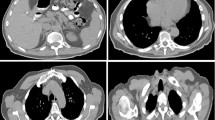Abstract
Many medical image processing applications rely on targeted regions of interest within a larger volumetric image. Whole-body scans represent an extreme case in which large volumes must be broken into smaller sub-volumes for regional analysis. In this work, we sought automatic solutions to divide medical X-ray computed tomography (CT) images into six main anatomical regions: head, neck, chest, abdomen, pelvis and legs. We implemented and compared three methods: (1) an analytical approach which does not require training and solely relies on utilizing critical points in image intensity profiles to derive cut-planes that divide the scan into the mentioned regions, (2) a classical convolutional neural network (CNN) approach, which classifies each transaxial 2D plane independently and then concatenates classification results, and (3) CNN followed by a context-based correction algorithm (CBCA) which improves the CNN classification using positional relationships between all CT slices. The analytical approach achieved acceptable accuracy for anatomical region segmentation without the need for explicit data labeling and was effective for batch labeling whole-body CTs, greatly reducing manual labeling efforts. CNNs achieved superior accuracy and allowed for rapid development and training, but required labeled data and were susceptible to produce discontinuous anatomical regions and therefore ambiguous anatomical boundaries. Post hoc correction of CNN results using CBCA overcame these limitations, achieving nearly perfect CT slice labeling and anatomical region segmentation.







Similar content being viewed by others
References
Klein R, Renaud JM, Ziadi MC, Thorn SL, Adler A, Beanlands RS, DeKemp RA (2010) Intra- and inter-operator repeatability of myocardial blood flow and myocardial flow reserve measurements using rubidium-82 pet and a highly automated analysis program. J Nucl Cardiol 17(4):600–616
Zhou X, Takayama R, Wang S, Hara T, Fujita H (2017) Deep learning of the sectional appearances of 3D CT images for anatomical structure segmentation based on an FCN voting method. Med Phys 44(10):5221–5233
Vania M, Mureja D, Lee D (2019) Automatic spine segmentation from CT images using convolutional neural network via redundant generation of class labels. J Comput Des Eng 6(2):224–232
Cordier N, Delingette H, Ayache N (2015) A patch-based approach for the segmentation of pathologies: application to glioma labelling. IEEE Trans Med Imaging 35(4):11
Sun J, Chen W, Peng S, Liu B (2019) DRRNet: dense residual refine networks for automatic brain tumor segmentation. J Med Syst 43(7):221
Goo HW (2012) CT radiation dose optimization and estimation: an update for radiologists. Seoulm 13(1):1–11
Cho J, Lee K, Shin E, Choy G, Do S (2015) Medical image deep learning with hospital PACS dataset. arXiv:1511.06348
Yosinski J, Clune J, Bengio Y, Lipson H (2014) How transferable are features in deep neural networks? In: Advances in neural information processing Systems, vol 27 (NIPS ’14). NIPS Foundation, pp 3320–3328
Razavian AS, Azizpour H, Sullivan J, Carlsson S (2014) CNN features off-the-shelf: an astounding baseline for recognition. In IEEE conference on computer vision and pattern recognition workshops
Donahue J, Yangqing J, Vinyals O, Hoffman J, Zhang N, Tzeng E, Darrel T (2013) DeCAF: a deep convolutional activation feature for generic visual recognition. UC Berkeley & ICSI, Berkeley
Garcia-Gasulla D, Vilalta A, Parés F, Moreno J, Ayguadé E, Labarta J, Cortés U, Suzumura T (2018) An out-of-the-box full-network embedding for convolutional neural networks. In: 2018 IEEE international conference on big knowledge (ICBK). IEEE, pp 168–175
Szegedy C, Liu W, Jia Y, Sermanet P, Reed S, Anguelov D, Erhan D, Vanhoucke V, Rabinovich A (2015) Going deeper with convolutions. In: IEEE conference on computer vision and pattern recognition, pp 1–9
Roth H, Lee C, Shin H, Seff A, Kim L, Yao J, Lu L, Summers R (2015) Anatomy-specific classification of medical images using deep convolutional nets. In: IEEE 12th international symposium on biomedical imaging (ISBI). IEEE
Schmidhuber J (2015) Deep learning in neural networks: an overview. Neural Netw 61:85–117
Andersen HK, Jensen K, Berstad AE, Aaløkken TM, Kristiansen J, von Gohren EB, Hagen G, Martinsen AC (2014) Choosing the best reconstruction technique in abdominal computed tomography: a systematic approach. J Comput Assist Tomogr 38(6):853–8
Patrick S, Birur NP, Gurushanth K, Raghavan AS, Gurudath S (2017) Comparison of gray values of cone-beam computed tomography with hounsfield units of multislice computed tomography: an in vitro study. Indian J Dent Res 28(1):66
Kuntz E, Kuntz HD (2006) Hepatology, principles and practice: history, morphology, biochemistry, diagnostics, clinic, therapy. Springer, New York
Lepor H (2000) Prostatic diseases. W.B. Saunders Company, New York, p 83
Marsaglia G, Tsang W, Wang J (2003) Evaluating Kolmogorov’s distribution. J Stat Softw 8(18):1–4
Massey FJ (1951) The Kolmogorov–Smirnov test for goodness of fit. J Am Stat Assoc 46(253):68–78
Miller LH (1956) Table of percentage points of Kolmogorov statistics. J Am Stat Assoc 51(273):111–121
McDonald J (2008) Handbook of biological statistics. Sparky House Publishing, Baltimore
Acknowledgements
The authors wish to thank Spencer Manwell for proofreading the manuscript and providing insightful feedback. This work was supported in part by The Division of Nuclear Medicine and also by the Natural Science and Engineering Research Council of Canada, Engage Grant 516276-17 with in-kind support from Hermes Medical Solutions of Canada.
Author information
Authors and Affiliations
Corresponding author
Ethics declarations
Conflict of interest
This research has no conflict of interests.
Additional information
Publisher's Note
Springer Nature remains neutral with regard to jurisdictional claims in published maps and institutional affiliations.
Rights and permissions
About this article
Cite this article
Salman, O.S., Klein, R. Anatomical region identification in medical X-ray computed tomography (CT) scans: development and comparison of alternative data analysis and vision-based methods. Neural Comput & Applic 32, 17519–17531 (2020). https://doi.org/10.1007/s00521-020-04923-6
Received:
Accepted:
Published:
Issue Date:
DOI: https://doi.org/10.1007/s00521-020-04923-6




